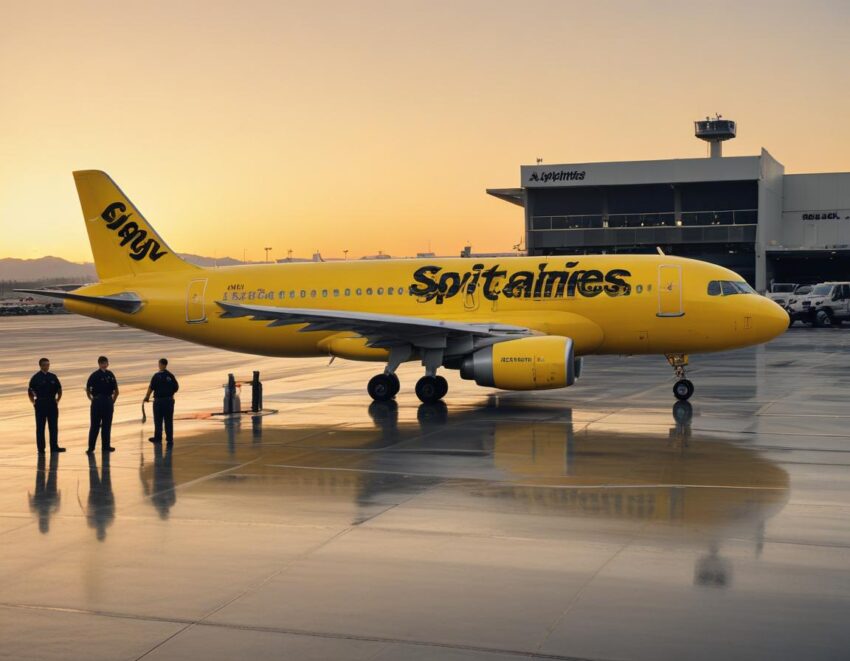
Spirit Airlines will furlough two hundred seventy pilots as part of its post-bankruptcy realignment. This major move reflects the growing challenges in US travel demand. After emerging from Chapter 11 bankruptcy earlier this year, Spirit has struggled to regain stability. The airline, known for its ultra-low-cost model, now faces slower-than-expected recovery and weaker bookings. As a result, it must cut costs and restructure operations quickly. One of the most immediate effects is the planned pilot layoffs, which are set to take effect on November 1.
This furlough decision is tied directly to airline schedule cuts that Spirit is implementing across its network. By reducing off-season flights, the carrier hopes to control spending while adapting to market conditions. The airline has also announced the demotion of 140 pilots from captain to first officer. These changes underscore the airline’s effort to remain viable as it shifts into a leaner post-bankruptcy phase.
Spirit Airlines made it clear that these pilot layoffs are not a one-time event but part of a broader post-bankruptcy recovery strategy. In a volatile aviation environment where demand patterns continue to shift, Spirit is aligning its workforce with revised business goals. While other carriers focus on expanding, Spirit is pulling back to regroup. US travel demand in economy-class sectors has cooled this year, making such reductions unavoidable.
In short, Spirit Airlines is confronting the reality of a tougher market. Furloughing two hundred seventy pilots marks a significant but necessary step in its post-bankruptcy realignment.
Spirit Airlines to Furlough 270 Pilots as Part of Post-Bankruptcy Realignment
Spirit Airlines will furlough 270 pilots this fall as part of a major restructuring aimed at stabilizing its post-bankruptcy operations. In addition to the furloughs, the airline will demote 140 captains to first officer roles, with changes taking effect from October 1 and November 1 respectively. This drastic step comes just months after the low-cost carrier emerged from Chapter 11 bankruptcy in March 2025. Despite efforts to reposition itself with upgraded services and new fare classes, Spirit continues to face fierce industry headwinds, including soft demand for coach-class travel and tighter margins during off-peak periods. The move reflects a stark shift for the carrier, which has long capitalized on volume and low-cost routes. According to Spirit’s official statement, these actions are meant to “align staffing with our flight schedule,” underscoring how shrinking operations are now reshaping its labor force and flight network.
Post-Bankruptcy Realignment Fails to Prevent Deep Cuts
After re-emerging from Chapter 11 just four months ago, Spirit Airlines hoped to turn the page on a turbulent financial chapter. However, its updated flight strategy and premium fare experiments have not shielded it from broader market pressures. The company has seen lackluster demand for economy travel, which traditionally drove its growth. The planned furlough of 270 pilots and the downgrade of 140 others reveal the extent of the operational recalibration. A note circulated by the Air Line Pilots Association (ALPA) confirmed the staffing changes, calling the move a “direct hit” to seniority and career progressions. Ryan Muller, chairman of Spirit’s ALPA chapter, voiced concern over the long-term impact of the shrinking footprint, warning that the erosion of pilot ranks will continue if trends don’t reverse. The company’s recovery strategy—previously centered on attracting new customers with upscale add-ons—has yet to show meaningful traction.
Spirit’s Statement Highlights Operational Efficiency Over Expansion
Spirit Airlines issued a statement emphasizing that these changes are necessary steps to protect the company’s future. By trimming its pilot roster and streamlining operations, the carrier hopes to return to profitability amid turbulent market conditions. The airline acknowledged the emotional and professional toll these decisions would have on its team members. It noted that all affected pilots would be treated with “compassion and respect.” While such reassurances may offer limited comfort, they underscore Spirit’s attempt to preserve company culture during a challenging transition. As part of its restructuring, the airline is also reducing its off-peak flight schedule and concentrating resources on more profitable routes. This tactical shift signals a departure from its historic volume-based business model. Spirit has not announced which specific routes will be cut, but analysts expect the changes to impact less-trafficked domestic flights, especially those serving smaller airports across the U.S.
Pilot Demotions Add to Longstanding Workforce Struggles
The announcement to demote 140 captains to first officers is a highly unusual step in the airline industry and represents a significant career setback for the affected aviators. Pilot hierarchy, built over years of experience and certifications, is central to compensation and job satisfaction. This downward movement will likely result in both pay cuts and reduced flying hours for demoted staff. Spirit had already furloughed pilots in 2024 before its bankruptcy declaration. The recurrence of similar decisions within a 12-month period illustrates a deeper fragility in the airline’s labor model. Pilot unions have expressed frustration with the lack of long-term workforce stability, arguing that Spirit’s volatility is making it difficult to retain skilled personnel. Meanwhile, union representatives are continuing negotiations on severance benefits and reemployment options. There is also concern that the latest round of staffing reductions could delay scheduled training for new pilots, creating a bottleneck in future hiring cycles.
Soft Demand and Seasonal Dips Plague Budget Airlines
Spirit is not alone in confronting a rough patch in 2025. Budget airlines across the U.S. have reported softer-than-expected demand, especially in traditionally slow travel seasons like autumn. This trend runs counter to earlier predictions of sustained post-pandemic growth. Analysts suggest that rising inflation, high fuel costs, and growing competition in the low-cost travel segment are weakening margins. Spirit, with its heavy reliance on coach-class volume and ultra-low fare offerings, is particularly exposed. Attempts to rebrand with upgraded seating, bundled services, and loyalty perks have yet to gain widespread acceptance among travelers. Some passengers still associate the airline with bare-bones service and unpredictable schedules—factors that continue to hurt repeat business. In contrast, major carriers like Delta and United have found success in expanding premium cabin options and capitalizing on business travel recovery. Spirit’s short-term strategy now hinges on carefully managing costs rather than chasing aggressive expansion.
Operational Challenges Mount as Fleet Adjustments Loom
Beyond staffing cuts, Spirit may soon face decisions about its fleet composition. With a smaller schedule ahead, the airline could place some of its aircraft in storage or return leased units. Industry insiders say that older Airbus A319s might be the first to exit active rotation. Reduced utilization not only affects maintenance costs but also limits the airline’s ability to respond to sudden surges in demand. In previous years, Spirit had leveraged seasonal flexibility to deploy extra capacity during peak times. That option may no longer be viable if staffing and scheduling remain constrained. Delays in new aircraft deliveries—common across the industry—could further complicate long-term fleet strategy. As of mid-2025, Spirit operates more than 190 aircraft, with the A320 family comprising the bulk of its fleet. The airline has not yet confirmed any grounded units or route terminations tied to the recent furloughs, but more updates are expected before the winter travel season.
Customer Perception and Brand Recovery Remain a Hurdle
One of Spirit’s biggest post-bankruptcy hurdles is convincing customers to give the airline another chance. Despite implementing modest upgrades in in-flight experience and booking flexibility, public perception still lags. Many frequent flyers remain cautious, associating the brand with frequent delays, hidden fees, and basic service. The current wave of flight and pilot cuts could further erode consumer confidence. Travel analysts warn that negative headlines about furloughs and demotions are unlikely to inspire confidence in the airline’s stability. This poses a risk to Spirit’s ongoing efforts to regain market share in key cities like Orlando, Fort Lauderdale, and Los Angeles. Some marketing campaigns have attempted to reframe Spirit as a value-focused brand with modern flair, but these efforts are still in early stages. Until operational reliability improves and schedules stabilize, customer acquisition will likely remain a challenge. Loyalty program improvements and partnerships with travel aggregators may offer a short-term boost.
Conclusion: A Testing Period for Spirit’s Long-Term Future
The coming months will be a crucial test for Spirit Airlines. The Spirit Airlines furlough announcement signals a pivot away from growth and toward consolidation. By November 2025, the airline will have substantially reduced its pilot workforce and implemented route changes designed to minimize losses. Whether these moves can restore profitability without permanently damaging brand equity remains unclear. Spirit’s journey through bankruptcy, realignment, and now workforce reduction paints a picture of a carrier still trying to find its place in a shifting aviation landscape. For now, operational discipline and cost control appear to be the airline’s primary focus. However, with traveler expectations rising and competitors expanding, Spirit must find a path to reinvention that balances efficiency with customer appeal. The aviation world will be watching closely to see whether this strategy can help the carrier reclaim stability or if more turbulence lies ahead.
The post Spirit Airlines to Furlough Two Hundred Seventy Pilots as Part of Post-Bankruptcy Realignment appeared first on Travel And Tour World.from Travel And Tour World https://ift.tt/3WtEKRx
via >EPR


